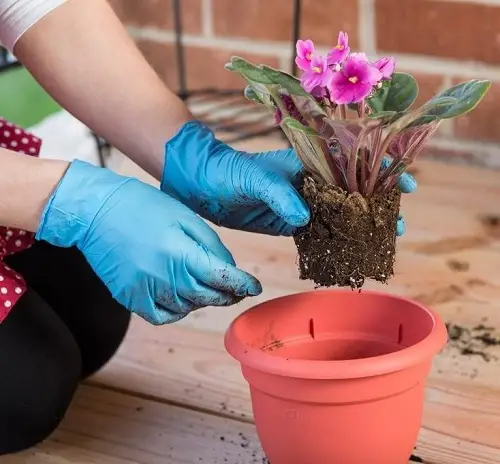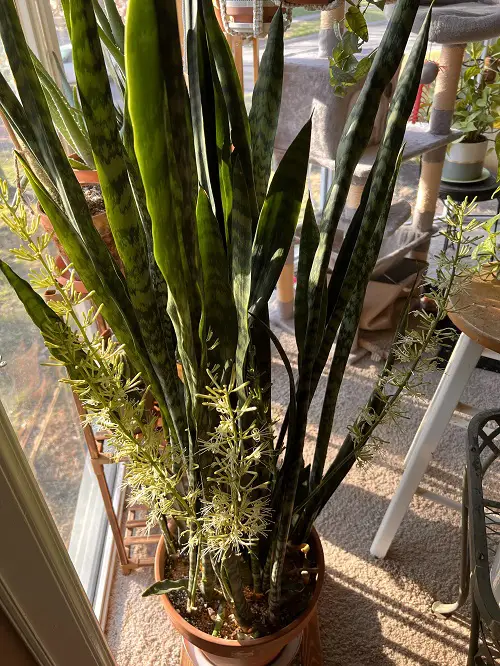Some houseplants prefer snug, tiny homes to spacious containers! Let’s explore these Indoor Plants that Flower More when Rootbound.
Certain plants produce more flowers when mildly stressed due to being slightly rootbound. These specimens do well without frequent repotting and surprisingly flower more when their roots are a tangled-up little ball.
Happy to be Rootbound?
When potbound, some houseplants put more energy into showing more top growth and blooming than growing roots. They perceive limited root space as a signal to reproduce or flower rather than expand. Also, once planted, they may dislike being transplanted or moved around.
Some others on this list are epiphytic or have shallow roots. Less root space mimics their native growing conditions with limited access to nutrients. Flowering thus becomes a way to survive and spread.
However, pay attention to each plant’s growing medium and nutrition, so they thrive while being rootbound. Once you get their basic needs down, you can bid barren flowerless pots adieu and keep unwanted growth in check by keeping these indoor plants potbound!
6 Indoor Plants that Flower More when Rootbound
1. Peace Lily

Botanical Name: Spathiphyllum
When potbound, peace lily produces more flowers as the plant focuses its energy on blooming rather than spreading roots. With large, deep green, glossy leaves and white to pale green spathes, this tropical stunner is also a powerful air purifier.
It prefers partial to full shade, enjoys initial planting in a slightly bigger container than the rootball, and needs a potting mix rich in organic matter.
Caution: Peace lily contains calcium oxalate crystals that are toxic when ingested.
2. African Violet
Botanical Name: Saintpaulia
African Violets have tiny, bright blooms and dark green, fuzzy leaves that make a beautiful floral addition to any home. Native to eastern tropical Africa, they are not true violets despite the resemblance.
Saintpaulia blooms better in slightly stressed conditions, and keeping it rootbound can stress it into flowering all year round! It thrives in bright, filtered sunshine, moist but not soggy soil, fertile medium, and good humidity.
Caution: This plant may trigger some allergic reactions due to its pollen
3. Christmas Cactus

Botanical Name: Schlumbergera
Christmas Cactus is an epiphytic succulent with a shallow root system. In its native habitat, it grows on tree branches, absorbing water and nutrients from the air. Keeping it potbound imitates similar conditions, forcing it to bloom as a method of survival.
As the festive season nears, you can do a few other things in fall to coax it to produce more of its famous tubular, pink, and red flowers.
4. Kalanchoe

Botanical Name: Kalanchoe blossfeldiana
You can never have enough of Kalanchoe’s clusters of bright orange to red blooms emerging from its attractive, fleshy, serrated foliage. Mild stress from tight roots and exposure to low light during fall and winter will give you abundant flowerful plants.
Kalanchoe is a short-day plant that needs a crucial photoperiod of 14 hours to bloom. Reducing its exposure to light and taking a few other steps will force it to bloom.
5. Anthurium

Botanical Name: Anthurium andraeanum
Anthuriums are next on our list of indoor plants that produce more flowers when rootbound. The stress of being potbound encourages laceleaf to produce blooms. Plant enthusiasts can utilize this trick to get abundant heart-shaped, waxy, reddish-pink flowers.
Thriving in dappled sunshine, high humidity, and moist soil, avoid keeping laceleaf in an extreme potbound state. If you find the plant struggling or roots poking through the bottom or bungling up the surface, it’s time to repot.
6. Snake Plant
Botanical Name: Dracaena trifasciata
Finally, this classic indoor favorite may surprise you with more flowers when rootbound! Snake plants often bloom when they experience mild stress. One common cause is being pot-bound, where the roots completely encircle the pot.
This tight space can mimic the challenging conditions of its natural environment and force it to flower or reproduce. Find out in detail how to get a snake plant to bloom.




